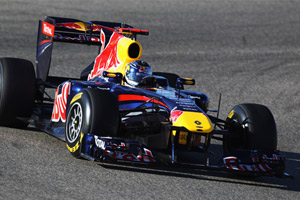ringo wrote:The more force over the tyre the better.
I don't buy that they are taking more life out of them becuase of downforce.
They are taking more life out of them becuase they are using the DRS in areas where it's not supposed to.
The car has so much downforce that even when unballanced (under drs use), and wearing the tyres disproportionately it's still sticking to the track.
I'd say in qualifying they are scrubbing the tyres more and messing up the balance because of using DRS to take downforce of the rear in the turns.
I could be totally wrong as i'm no tyre guru, but more downforce is the reason why those guys get the longest tyre life over the other teams.
Unless they are setting up the camber and toe aggressively, i see no reason why "30 points" more down-force is punishing their tyres.
Horner is beating around the bush with that, but what we do know is that the car wasn't working as perfectly on the new hard tyre. Which could simply be due to data gathering and learning the tyre.
Give a driver more downforce and he will go quicker, still putting the car to limit of adhesion (when he needs to) without going over (at a higher cornering speed than others with less DF) . The driving "envelope" in every corner ( not over or under) at the limit for a F1 driver is a very small one, they put the car on the limit from entry to exit.
Down force is only increasing the MPH. It also increases the work of the tire, which will shorten it's life, though not as quickly as the car that is difficult to drive or being overdriven to catch a car with higher DF, thus an increase of sliding the car.
Drivers who are considered good with saving tires, don't drive at the limit but slightly under it, to conserve their tires. As Button stated that with the Pirelli's, he had to back off so much that he was under the DF produciton ability of the car and the car would slide, purely due to lack of speed. Even for Button the Pirelli's are a difficult challenge.
IMHO, Downforce means less chances of sliding the car (saving potential damage to the tire), but is an increase in the work load of the tires, so yes, more caring for the tire, but not a longer life than a car with less down force (but not being over driven and abusing the tire).
As this is the first race of the year that the RB7 was "tested" in a race condition, were the car spent most of the race driven at the limit, the pit stop lengths of the tire stint, when measured against the Mclaren, shows the Mclaren is using it's tires more efficiently. All except the last two stops when the teams matched pitstops (I believe) for tactical reasons. This was also true of the first stint of Auzzie, when Hamilton did more laps (3) before pitting, the rest of the race a wash due to the broken splitter. Yet, the RB7 has more downforce? If it was "more" caring on the tire and making it last longer, why stop before the other teams? (speaking of the options)
An increased DF causing more work load of the contact patch, means more area on an abrasive surface (asphalt). Somehow more work equals less wear? But the driver less likely to abuse the tire because he's driving a more stable platform and less likely to "have to" exceed the car, is more caring and more friendly to the tire. In that respect you have a point, but less tire wear? not a physical probability.
"Driving a car as fast as possible (in a race) is all about maintaining the highest possible acceleration level in the appropriate direction." Peter Wright,Techical Director, Team Lotus



